Use of Model-Based Weather Forecasting Systems for Validation of Areas for Marine Energy Deployment in Port Service Areas
Abstract
Featured Application
Abstract
1. Introduction
2. Role of Ports in the Decarbonisation of Maritime Transport
2.1. Key Regulations Driving Change
- International Maritime Organization (IMO): The IMO’s Initial Strategy for Reducing GHG Emissions from Ships aims to cut emissions by at least 50% by 2050 compared to 2008 levels. The introduction of the Energy Efficiency Existing Ship Index (EEXI) and Carbon Intensity Indicator (CII) regulations in 2023 enforces compliance with stricter efficiency standards [1].
- European Green Deal: The European Union (EU) has adopted the Fit for 55 legislative packages, including the Fuel EU Maritime Initiative. This initiative mandates a gradual shift towards alternative fuels and sets specific reduction targets for GHG emissions from shipping by 2030 and 2050 [5].
- Alternative Fuels Infrastructure Regulation (AFIR): The EU has proposed new infrastructure requirements for alternative fuel supply, ensuring ports are equipped with refuelling facilities for sustainable fuels like hydrogen, methanol, ammonia, and bio-LNG [13], among others.
2.2. Role of Ports in the Energy Transition and Technological Developments
2.3. Integration of Renewable Energy in Ports
3. Maritime-Port Operations That Are Likely to Be Carried out with a More Sustainable Energy Model
4. Met-Ocean Strategy for Assessing the Feasibility of Marine Renewable Energy near Ports
4.1. Introduction
4.2. Selection of the Most Suitable Agitation Model
4.3. Bathymetric, Port Contour/Typologies, Instrumental Data, and Forcing Used
4.4. Selection of Coastal/Port Contour Reflection Coefficients
4.5. Design of the MSP Numerical Grid
4.6. Model Runs and General Results
4.7. Pre-Operational Validation and System Calibration
4.8. Post-Processing
5. Conclusions and Future Perspectives
5.1. Integration of Marine Renewable Energy in Port Operations
5.2. The Role of Predictive Modelling in Enhancing Energy Feasibility Assessments
5.3. Implications for Port Sustainability and Energy Sovereignty
5.4. Future Directions and Research Opportunities
- Refine small-scale hydrodynamic modelling;
- Explore hybrid systems (wind + wave + solar);
- Assess socio-economic feasibility of marine energy technologies.
5.5. Final Considerations
Author Contributions
Funding
Institutional Review Board Statement
Informed Consent Statement
Data Availability Statement
Acknowledgments
Conflicts of Interest
References
- United Nations Conference on Trade and Development (UNCTAD). Review of Maritime Transport 2022. 2022. Available online: https://unctad.org (accessed on 26 January 2025).
- International Maritime Organization (IMO). Fourth IMO GHG Study 2020. 2020. Available online: https://www.imo.org (accessed on 26 January 2025).
- European Community Shipowners’ Associations (ECSA). Decarbonization Pathways for Maritime Transport. 2021. Available online: https://www.ecsa.eu (accessed on 26 January 2025).
- Port of Rotterdam. Shore Power Projects for Sustainable Shipping. 2023. Available online: https://www.portofrotterdam.com (accessed on 26 January 2025).
- European Commission. Fit for 55: Delivering the EU’s 2030 Climate Target on the Way to Climate Neutrality. 2021. Available online: https://eur-lex.europa.eu/legal-content/EN/TXT/HTML/?uri=CELEX:52021DC0550 (accessed on 26 January 2025).
- Available online: https://www.offshorewind.biz/2023/07/07/port-of-esbjerg-lines-up-eur-780-million-investment-in-offshore-wind-turbine-production-facilities (accessed on 17 March 2025).
- Pérez-Collazo, C.; Greaves, D.; Iglesias, G. A review of combined wave and off-shore wind energy. Renew. Sustain. Energy Rev. 2015, 42, 141–153. [Google Scholar] [CrossRef]
- Li, L.; Zhong, M.; Ma, X.; Zhao, H.; Safdar, M.; Chuwang, D.D.; Zhang, Z. Optimal planning of renewable energy infrastructure for ports under multiple design scenarios considering system constraints and growing transport demand. J. Clean. Prod. 2024, 477, 143827. [Google Scholar] [CrossRef]
- Hassan, G. Offshore Wind Resource Assessment Techniques. 2020. Available online: https://www.dnv.com (accessed on 26 January 2025).
- World Meteorological Organization (WMO). Advances in Numerical Weather Prediction for Ports. 2022. Available online: https://public.wmo.int (accessed on 26 January 2025).
- Informe de Emisiones de Gases de Efecto Invernadero del Puerto de Valencia. Año 2016. Available online: https://www.valenciaport.com/wp-content/uploads/Memoria-Verificaci%C3%B3n-GEI-2016.pdf (accessed on 3 March 2025).
- Kovalishin, P.; Nikitakos, N.; Boris Svilicic, B.; Zhang, J.; Nikishin, A.; Dalaklis, D.; Kharitonov, M.; Stefanakou, A. Using Artificial Intelligence (AI) methods for effectively responding to climate change at marine ports. J. Int. Marit. Saf. Environ. Aff. Shipp. 2023, 7, 2186589. [Google Scholar] [CrossRef]
- European Parliament. Alternative Fuels Infrastructure Regulation (AFIR). 2023. Available online: https://www.europarl.europa.eu (accessed on 28 January 2025).
- International Maritime Organization. Available online: https://www.imo.org/en/MediaCentre/PressBriefings/pages/IMO-approves-netzero-regulations.aspx (accessed on 25 April 2025).
- European Commission. Extension of the EU Emissions Trading System to Maritime Transport. 2022. Available online: https://ec.europa.eu (accessed on 28 January 2025).
- Port of Rotterdam. Hydrogen and LNG Bunkering Facilities. 2023. Available online: https://www.portofrotterdam.com (accessed on 28 January 2025).
- DNV. Maritime Forecast to 2050: Energy Transition Outlook. 2022. Available online: https://www.dnv.com/publications/maritime-forecast-to-2050-2022-edition-235251/ (accessed on 28 January 2025).
- European Sea Ports Organisation. Sustainable Ports in Europe: Shore-Side Electricity. 2022. Available online: https://www.espo.be (accessed on 28 January 2025).
- WindEurope. Floating Offshore Wind Farms: Opportunities for Ports. 2023. Available online: https://windeurope.org (accessed on 28 January 2025).
- Puertos del Estado. (n.d.). Red de Boyas: Información Meteorológica y Oceanográfica. Available online: https://www.puertos.es (accessed on 28 January 2025).
- Diaz-Hernandez, G.; Fernández, B.R.; Romano-Moreno, E.; Lara, J.L. An improved model for fast and reliable harbour wave agitation assessment. Coast. Eng. 2021, 170, 104011. [Google Scholar] [CrossRef]
- Vílchez, M.; Clavero, M.; Losada, M.A. Operational behaviour of a 2D breakwater: Synthesis and design performance curves. In Report EM 200; Instituto Interuniversitario de Investigación del Sistema Tierra en Andalucía. Sede CEAMA. Universidad de Granada: Granada, Spain, 2015. [Google Scholar]
- Vílchez, M.; Clavero, M.; Losada, M.A. Hydraulic performance of different non-overtopped breakwaters types under 2D wave attack. Coast. Eng. 2016, 107, 34–52. [Google Scholar] [CrossRef]
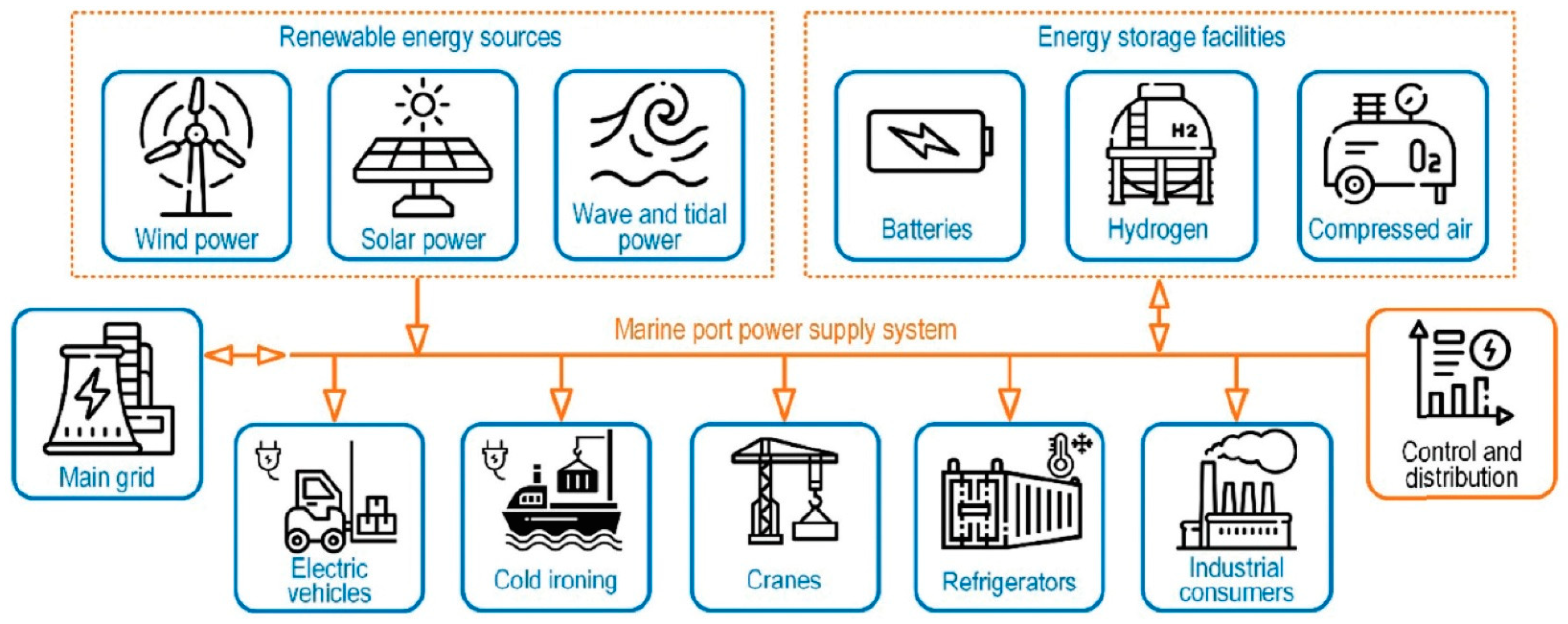
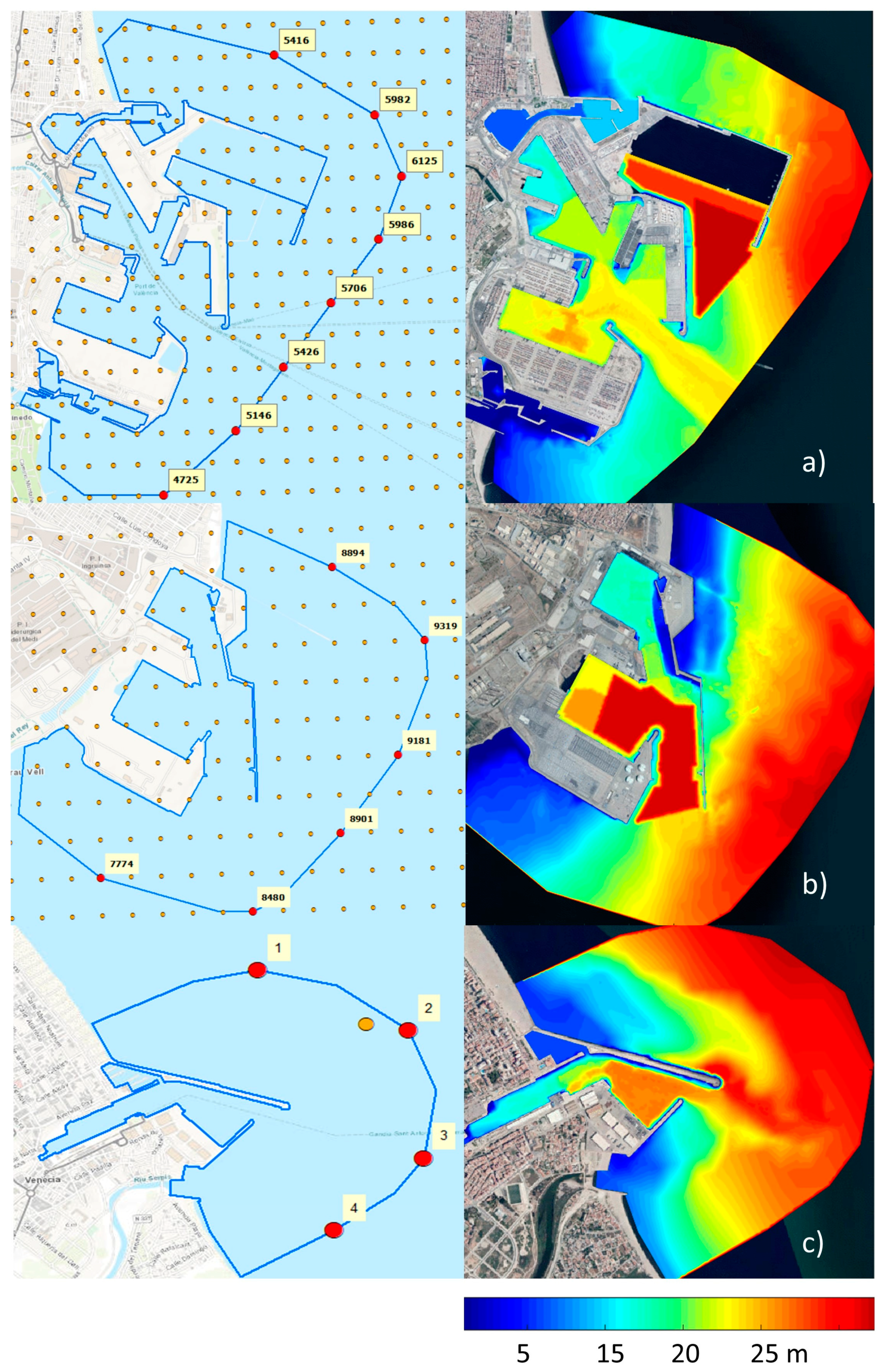
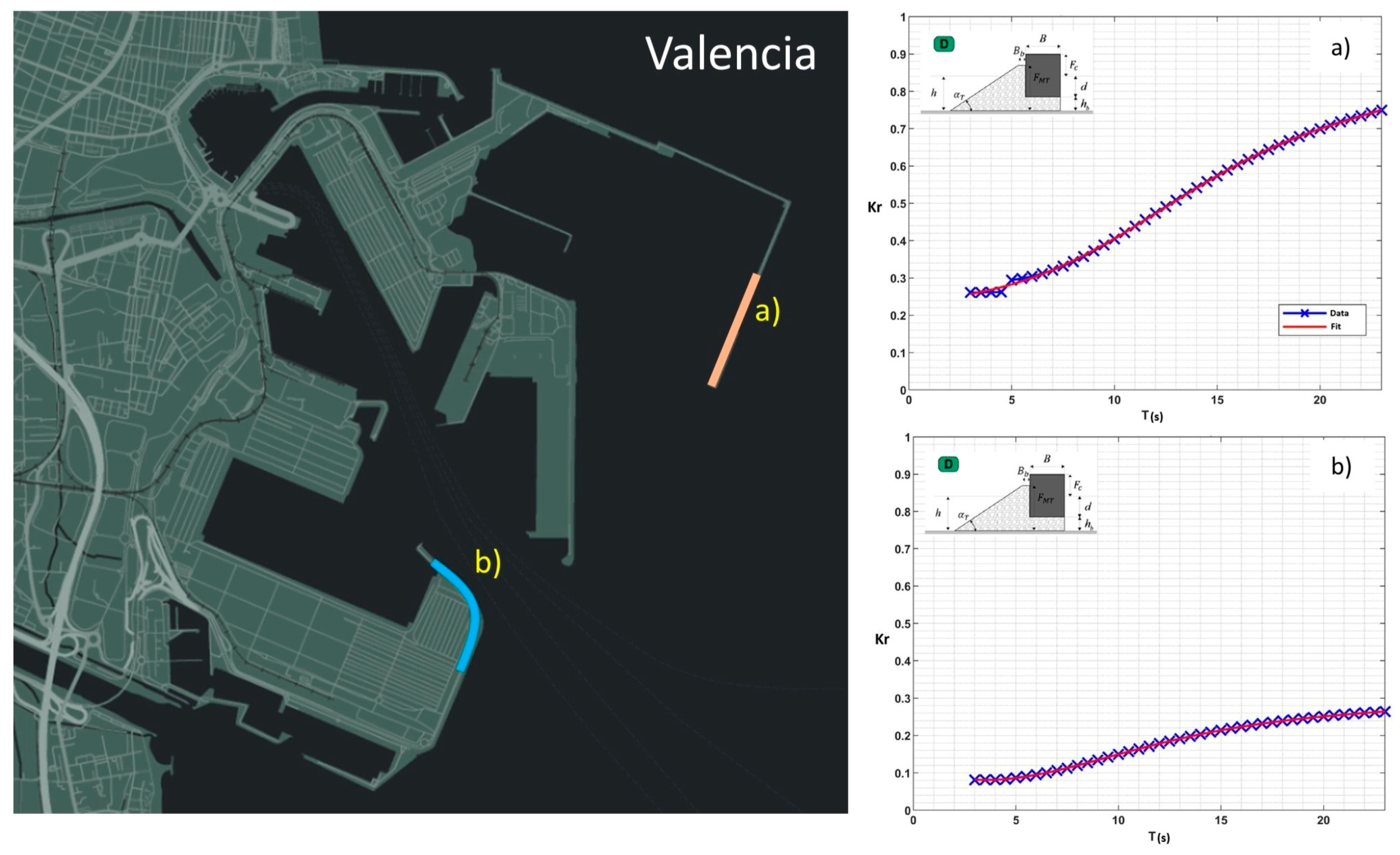
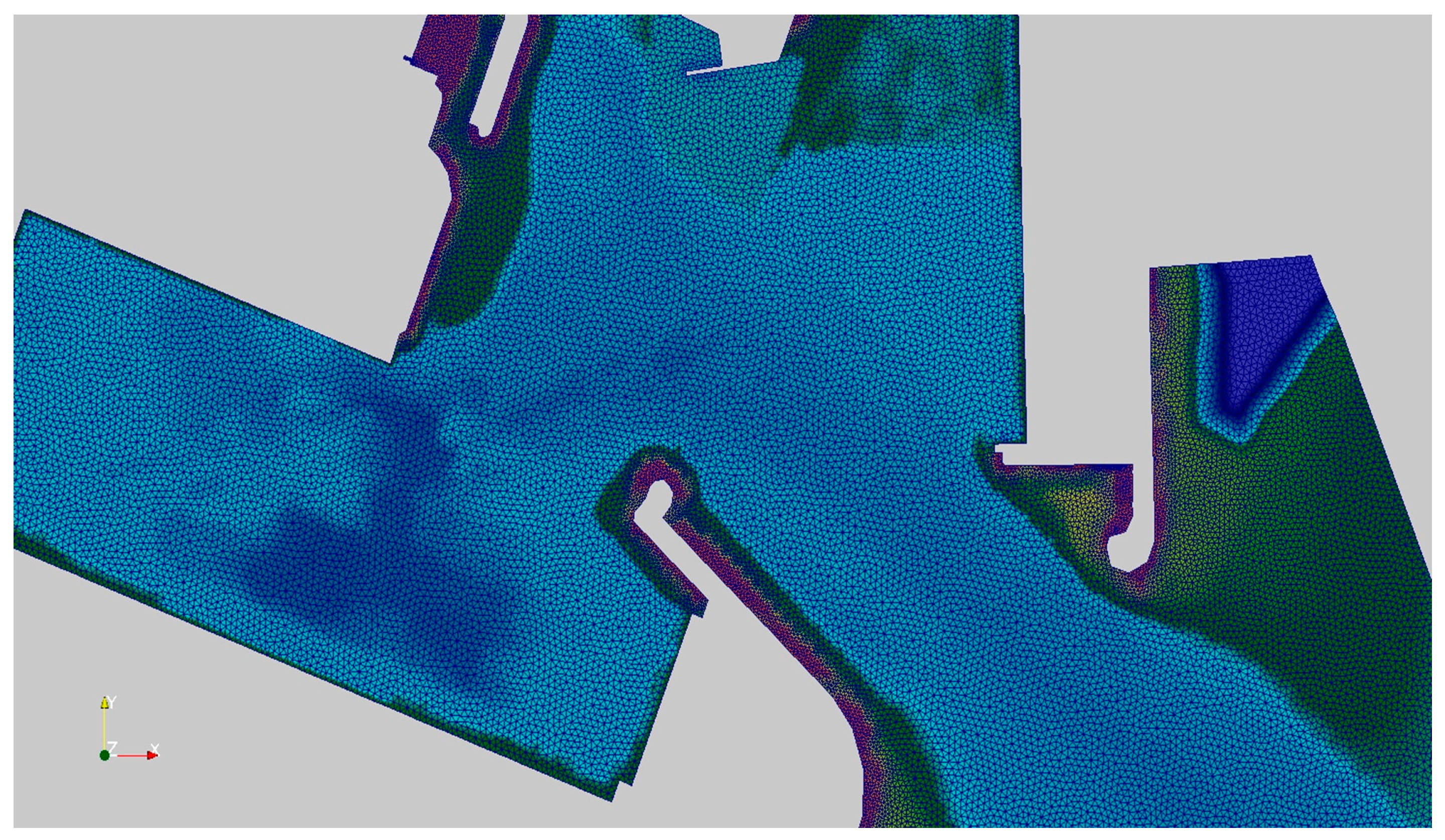
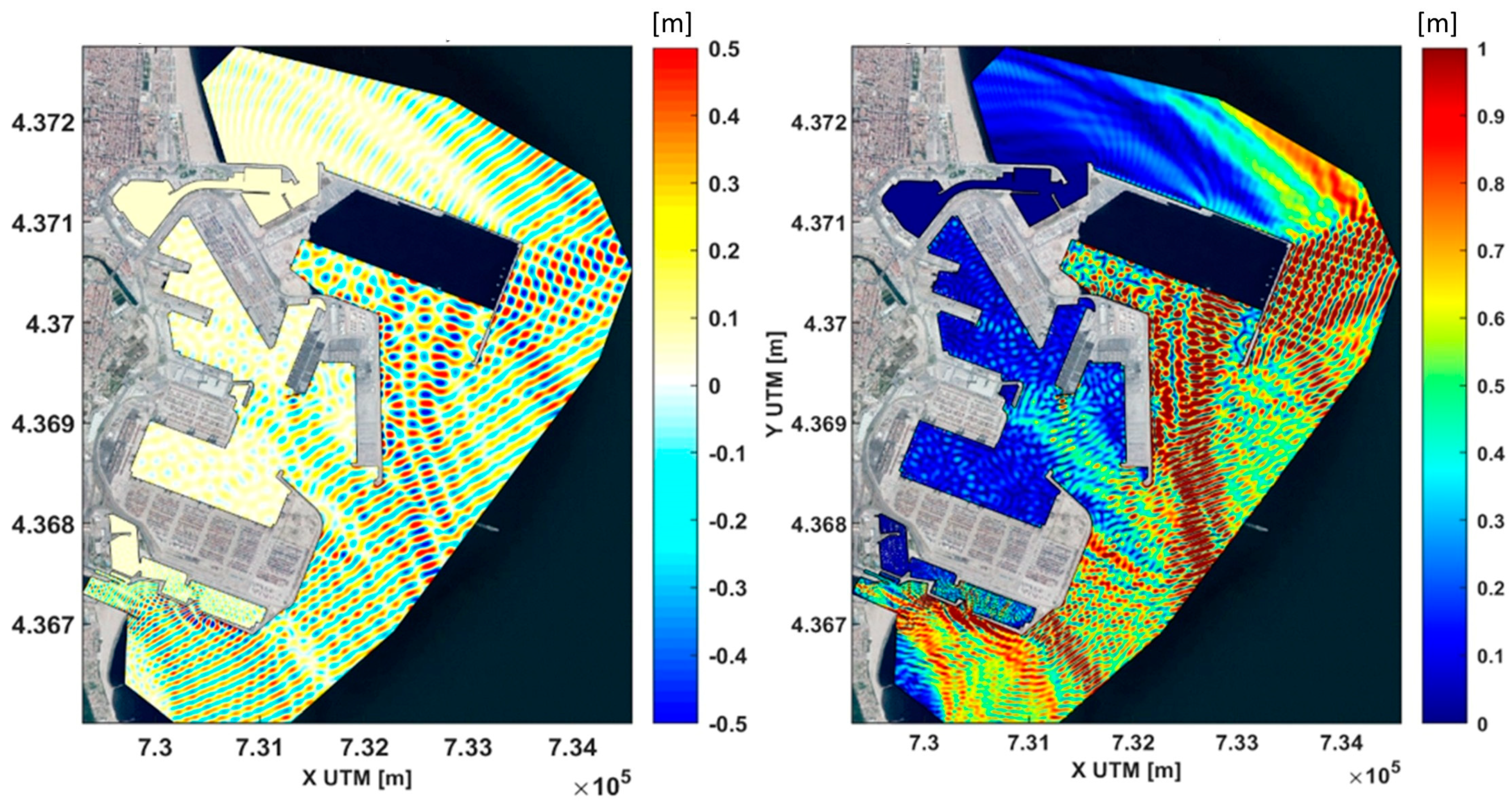
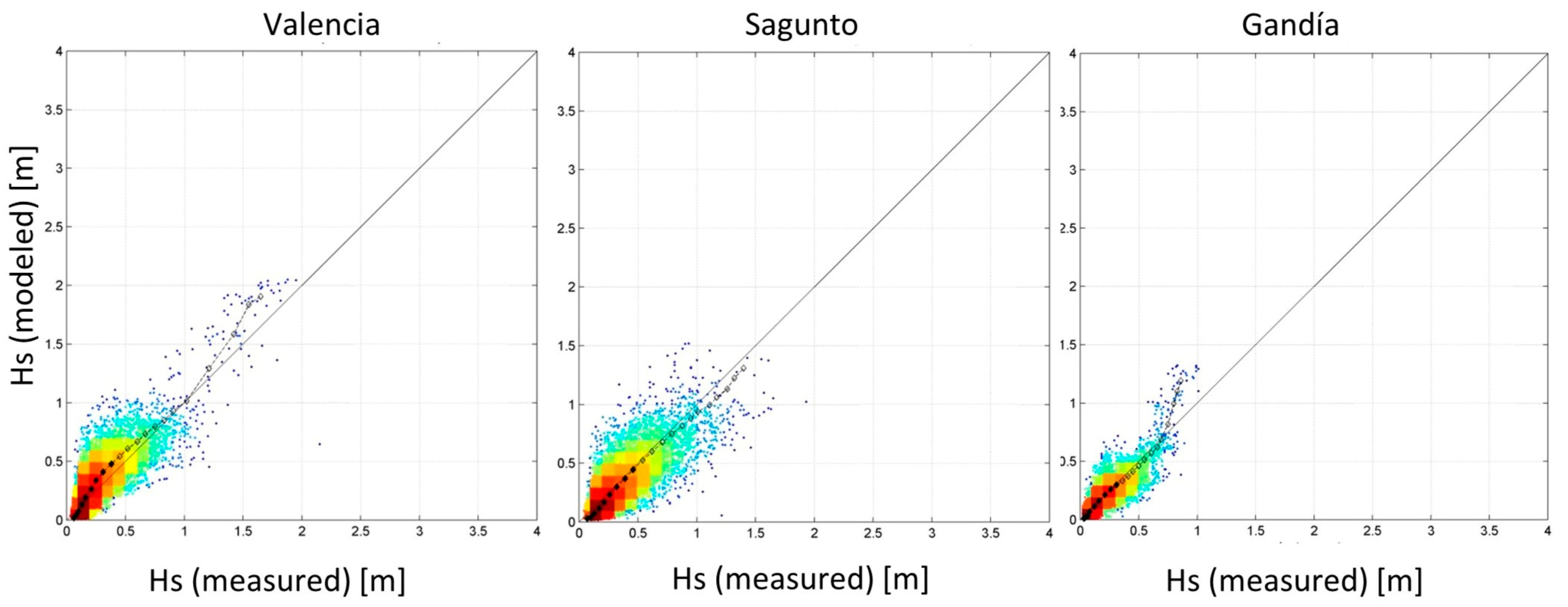
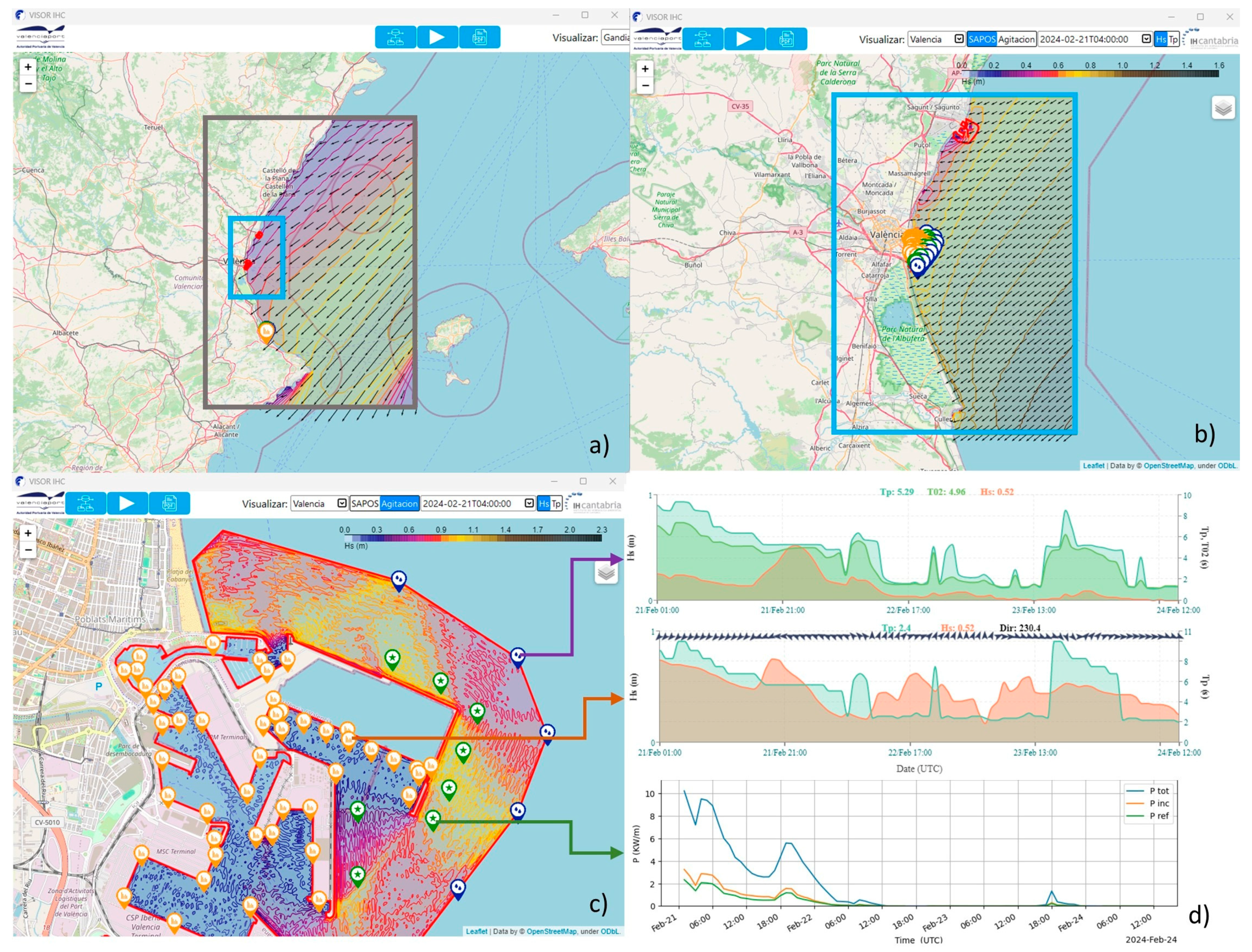
| Level | Name of Activity |
|---|---|
| 1 | Business-Oriented Activities (Managed by Concessionaires) |
| 1.1. | Passenger Terminals |
| 1.2. | Cargo Terminals: |
| 1.2.1 | Ro-Ro and Vehicle Terminals |
| 1.2.2. | Container Terminals |
| 1.2.3. | Multipurpose Terminals |
| 1.2.4. | Bulk Terminals |
| 1.2.5. | Petroleum and Chemical Terminals (Dangerous cargo) |
| 1.3. | Private Services: |
| 1.3.1. | Storage of Cargo |
| 1.3.2. | Repair of Ships and Shipyards |
| 1.3.3 | Supply to Ships |
| 1.3.4. | Nautical Services |
| 1.3.5. | Hospitality Services |
| 2. | Service-Oriented Activities (Managed by the Port Authority) |
| 2.1. | Infrastructure |
| 2.1.1. | Maintenance and Construction/Road Lighting |
| 2.2. | Port Services: |
| 2.2.1. | Pilots |
| 2.2.2. | Tugs |
| 2.2.3. | Mooring services |
| 2.3. | Administrative and Community Services: |
| 3. | Other activities |
| Port | # of Hours | BIAS | RMSE | SI | CORR | R2 |
|---|---|---|---|---|---|---|
| Valencia | 26,962 | 0.035 | 0.122 | 0.555 | 0.81 | 0.637 |
| Sagunto | 26,879 | −0.039 | 0.126 | 0.465 | 0.82 | 0.667 |
| Gandía | 26,745 | −0.010 | 0.065 | 0.400 | 0.88 | 0.778 |
Disclaimer/Publisher’s Note: The statements, opinions and data contained in all publications are solely those of the individual author(s) and contributor(s) and not of MDPI and/or the editor(s). MDPI and/or the editor(s) disclaim responsibility for any injury to people or property resulting from any ideas, methods, instructions or products referred to in the content. |
© 2025 by the authors. Licensee MDPI, Basel, Switzerland. This article is an open access article distributed under the terms and conditions of the Creative Commons Attribution (CC BY) license (https://creativecommons.org/licenses/by/4.0/).
Share and Cite
Cascajo, R.; Molina-Sánchez, R.; Diaz-Hernandez, G. Use of Model-Based Weather Forecasting Systems for Validation of Areas for Marine Energy Deployment in Port Service Areas. Appl. Sci. 2025, 15, 4948. https://doi.org/10.3390/app15094948
Cascajo R, Molina-Sánchez R, Diaz-Hernandez G. Use of Model-Based Weather Forecasting Systems for Validation of Areas for Marine Energy Deployment in Port Service Areas. Applied Sciences. 2025; 15(9):4948. https://doi.org/10.3390/app15094948
Chicago/Turabian StyleCascajo, Raúl, Rafael Molina-Sánchez, and Gabriel Diaz-Hernandez. 2025. "Use of Model-Based Weather Forecasting Systems for Validation of Areas for Marine Energy Deployment in Port Service Areas" Applied Sciences 15, no. 9: 4948. https://doi.org/10.3390/app15094948
APA StyleCascajo, R., Molina-Sánchez, R., & Diaz-Hernandez, G. (2025). Use of Model-Based Weather Forecasting Systems for Validation of Areas for Marine Energy Deployment in Port Service Areas. Applied Sciences, 15(9), 4948. https://doi.org/10.3390/app15094948








